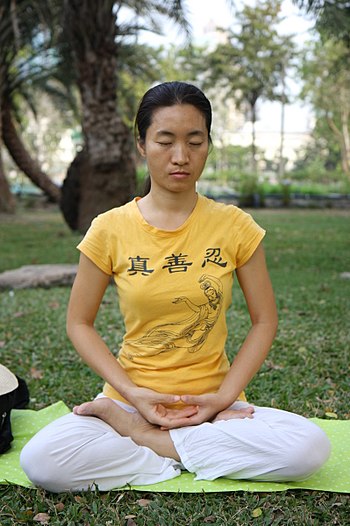The Philosophy
Zen Meditation is primarily designed to help a person gain insight and enlightenment. It is typically not a prayer session, but rather the intent is to seek enlightenment. The goal of each meditation is to come out of it with a deeper understanding - of yourself, the current challenges you’re facing, and the world as a whole.
Zen meditation is based on Buddhist philosophies which seek enlightenment through daily practice, thought, and action.
The Practice
| (Photo credit: Wikipedia) |
Zen meditation is practiced while sitting. There are a few acceptable poses you can take. They include:
- Legs crossed – both ankles are under your knees. This is generally the most comfortable position. As with all sitting positions it is important to keep your spine straight. This position is also called Burmese.
- Lotus – in this position the legs are crossed however your ankles and feet are on top of your legs or knees rather than under them. This can be a bit uncomfortable if you’re not used to it. You might start with a half lotus. This position is also called Kekkafuza.
- Half lotus – in this position you’re sitting cross legged. However, one foot is on top of the opposite knee. The other foot is under the opposite knee. This is also called Hankafuza.
- Kneeling – in this position your legs are tucked under you. You’re sitting back on your ankles, feet and calves. This position may be uncomfortable if you have knee strain. This position is also called Seiza.
- Chair – finally, you may sit upright in a chair with your feet planted firmly on the floor and your back straight.
Once you’re seated your hands are generally rest on your lap. They’re open and relaxed. One on top of the other and both open and facing up. Close your eyes and take five to seven deep cleansing breaths. The point of these two steps is to prepare your mind and body for meditation.
Focus On the Breath
The next step in Zen meditation is to focus on your breath. While it sounds simple, it can be tricky. You’ll find your breath begins to change simply because you’re thinking about it. It can begin to feel unnatural. The goal is to become aware of your breath. To simply notice how it fills your nose, fills your body and how it makes you feel. If your breath changes, simply be aware of that. You don’t need to control the breath. Relax into it.
Zen meditation asks then that you count your breaths. This helps you to be aware and focused on it. As you begin focusing on your breath thoughts will come into your mind. The goal is to eventually not have thoughts pop in and out. However, it is natural for them to do so. Don’t judge yourself. Simply allow the thought to pass out of your mind and refocus on your breath.
Initially, it’s recommended that you only try to mediate for five minutes. Once this time period feels natural and comfortable you can begin to extend it. The Zen meditation experience is different for everyone. The peace and clarity you find during mediation will allow awareness and insight to come to you.


No comments:
Post a Comment